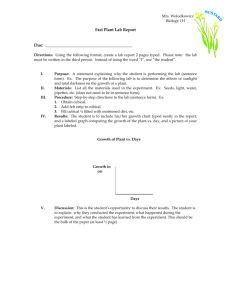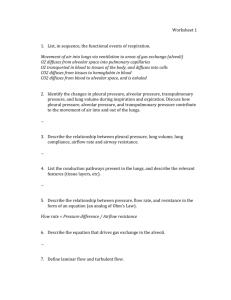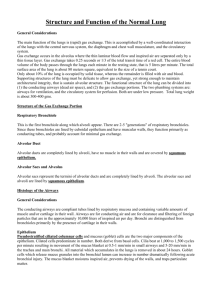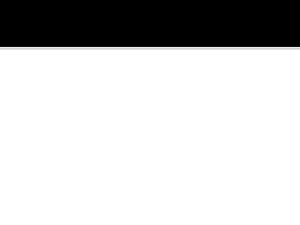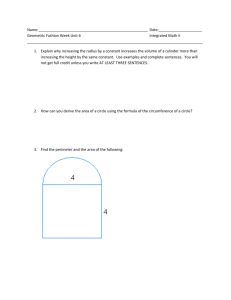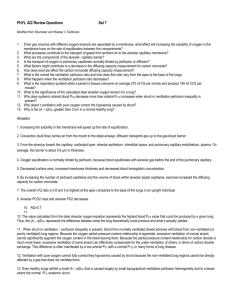The Origin of Dust-Cells in the Lung.
advertisement
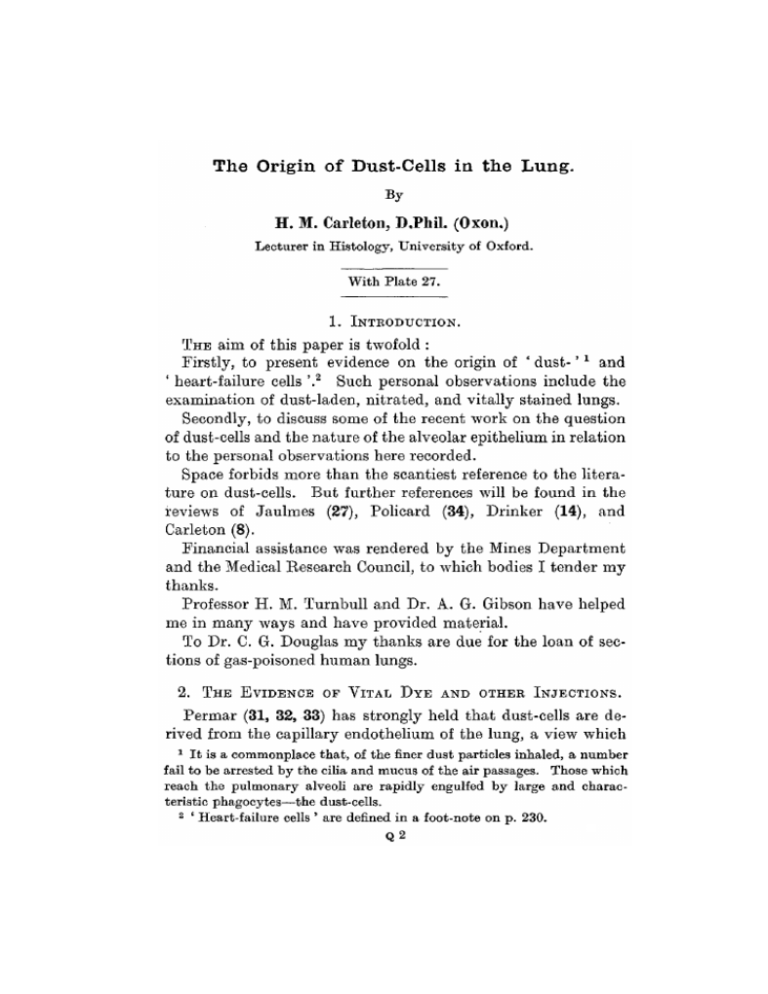
The Origin of Dust-Cells in the Lung.
By
H. M. Carleton, D.PM1. (Oxon.)
Lecturer in Histology, University of Oxford.
With Plate 27.
1. INTRODUCTION.
THE aim of this paper is twofold :
Firstly, to present evidence on the origin of ' dust-' x and
' heart-failure cells '? Such personal observations include the
examination of dust-laden, nitrated, and vitally stained lungs.
Secondly, to discuss some of the recent work on the question
of dust-cells and the nature of the alveolar epithelium in relation
to the personal observations here recorded.
Space forbids more than the scantiest reference to the literature on dust-cells. But further references will be found in the
reviews of Jaulmes (27), Policard (34), Drinker (14), and
Carleton (8).
Financial assistance was rendered by the Mines Department
and the Medical Eesearch Council, to which bodies I tender my
thanks.
Professor H. M. Turnbull and Dr. A. G. Gibson have helped
me in many ways and have provided material.
To Dr. C. G. Douglas my thanks are due for the loan of sections of gas-poisoned human lungs.
2. THE EVIDENCE OF VITAL DYE AND OTHER INJECTIONS.
Permar (31, 32, 33) has strongly held that dust-cells are derived from the capillary endothelium of the lung, a view which
1
It is a commonplace that, of the finer dust particles inhaled, a number
fail to be arrested by the cilia and mucus of the air passages. Those which
reach the pulmonary alveoli are rapidly engulfed by large and characteristic phagocytes—the dust-cells.
2
' Heart-failure cells ' are defined in a foot-note on p. 230.
Q2
224
H. M. CAELETON
is held by many other authorities (Drinker, 14; Foot, 17 ;
Haythorn, 26).
Permar's experiments were as follows : rabbits were given
daily intravenous injections of a 0-5 per cent, solution of isamine
blue in 0-9 per cent, saline. The maximum dose of isamine blue
was 60 c.c. over 9 or 11 days ; the minimum amount—producing
vital staining—was 35 c.c. in 8 days ; the average dose was
about 50 c.c. distributed over 8 days. Apparently the rabbits
were not weighed, so that the ratio of dye-stuff to the animal
kilo is unknown. During the course of the isamine-blue injections a suspension of carmine in 0-9 per cent, saline was injected
with a needle into the trachea.
In my experiments a rather weaker solution of isamine blue
—0-4 per cent/—was employed. This was because the higher
concentration used by Permar was found to be less stable and
more prone to clotting in the ear veins. Furthermore, a definite
dosage of sufficient strength to give good vital staining was
adhered to in all these experiments. This dosage was 4-3 c.c.
of the dye solution per kilo rabbit.
Intratracheal suspensions of carmine, finely divided coal-dust
and wood-charcoal were administered with aseptic precautions
under ether anaesthesia. The strength of these suspensions was
5 per cent, in 0-9 per cent, saline and the dosage 1-8 c.c. per
kilo animal.
In order to imitate the conditions under which foreign matter
normally enters the lungs, some experiments were made in the
dusting machine described elsewhere (10). Coal, haematite
(iron ore), and wood-charcoal dusts were used for this purpose
in the heaviest concentrations consistent with the avoidance
of choking.
An isamine-blue injection was always given during the intratracheal one. In the case of dusted animals the vital dye was at
once given after the inhalation. One to four vital-dye injections
were given after the pigment had been introduced into the lungs
so as to avoid Permar's criticism of Sewell's (37) work.
Frozen sections were made and examined in all cases ; in
addition, paraffin sections were prepared. When the total
J
4
ORIGIN OF DUST-CELLS
225
duration of dehydration did not exceed 2-4 hours only a little
of the dye was found to be extracted from vitally stained cells
on comparing the paraffin with the frozen sections.
The lungs were fixed in 5 per cent, formol (previously neutralized) in normal saline or in distilled water. Collapse was avoided
by tying off the trachea before opening the thorax. Often the
formol was injected, per tracheam, till the lungs were slightly
distended. They were then removed and placed in more of the
fixative.
Fourteen experiments were .made in all. Since the detailed
protocols of each experiment would entail needless repetition,
only a general summary is given.
Staining of dust-cells was but rarely observed. In some of
the experiments it was completely absent, in others a small
proportion of the cells—always under 2 per cent.—were stained.
The endothelial cells of the pulmonary capillaries occasionally
contained blue granules. It is significant that the number of
vitally stained cells was not widely different in animals which
had received injections of the vital dye only (i. e. controls) and
in animals which had had both the isamine blue a n d the pigment per tracheam. The scarcity of vitally stained cells in the
normal lung is well known (Goldmann, 18; Permar, loc. cit.).
In Permar's experience the number of vitally stained phagocytes increased greatly when the lungs were stimulated with
carmine ; the experience derived from the experiments here
recorded was that the number of vitally stained phagocytes increased very slightly or not at all after the introduction of
foreign particles into the lungs.
Very careful search was also made in thin and thick sections
for stages in the splitting off of endothelial cells from the capillaries, and their migration towards the alveolar epithelium.
Very occasionally an endothelial cell, more swollen than its
fellows, could be seen. Apart from the fact that this is no
formal proof of such a cell being about to leave the capillary
bed for the alveoli, the number of these swollen endothelial
elements was not found to be greater in lungs which had been
stimulated with pigment than in those which had not. If the
226
H. M. CARLBTON
capillary endothelium were furnishing phagocytes, signs of proliferative activity should have been abundant when one considers the immense numbers of dust-cells. I can only conclude
that Permar mistook for endothelial elements cells (e. g. histiocytes) which were really outside the capillary walls and which
were derived from other sources. The interpretation of thick
sections of lungs is very difficult owing to the different types of
cells that lie superimposed on one another.
The evidence of my series of vital-dye injections is that the
dust-cells were derived from cells lining the alveolar cavities.
At present the question of the origin of such cells is deferred
(see p. 231).
The evidence of tissue culture is totally at variance with an
endothelial origin of the dust-cells. Lang (28) and Carleton (7)
have cultivated lung in v i t r o . They both found that the
endothelial cells of the pulmonary capillaries were quite indifferent to pigment particles, although intense phagocytosis by
other cells was easily elicited. Both these authors also remark
on the absence of proliferation in the vascular endothelium i n
vitro.
The bearing of some recent important papers on the origin
of dust-cells may be considered here.
Westhues (40), in 1922, after injecting rabbits intravenously
with Indian ink noted that the endothelium of the lung capillaries did not take up the particles. A more recent paper by this
worker (41), while confirming the latter observation, goes far
to prove the origin of the dust-cells.
Westhues perfused a rabbit with normal saline so as to wash
out the blood-cells. Next he injected Indian ink into the
trachea. A piece of lung was then excised and placed in saline
at 37° C. for half an hour. A control fragment of lung was cut
out at the same time and fixed immediately in formol. In the
latter no phagocytosis could be seen. But in the former,
' remarkable phagocytosis ' was present in the alveoli.
The origin of the pigment-devouring cells was therefore restricted either to the cells in the alveoli or to the endothelium
of the lung capillaries.
ORIGIN OF DUST-CELLS
227
Supplementary experiments were devised to test the phagocytic power of the capillary endothelium. Indian ink was injected intravenously after previous removal of the blood-cells
by perfusion. Saline was then injected per tracheam. The
lungs were placed in warm saline as in the first experiment.
On sectioning them no phagocytosis could be seen in the capillaries—in spite of the ink particles—or elsewhere. Eepetition
of these experiments gave the same results. Occasional histiocytes were thought to help in the phagocytosis, but the most
active cells seem to have been undoubtedly derived from the
alveolar epithelium, since both the blood leucocytes (including
the histiocytes brought by the blood-stream to the lungs) and
the capillary endothelium were excluded.
Seeman (36) has shown that the intratracheal injection of
sugar of iron causes the appearance of cells both inside the
alveoli, and attached to the alveolar wall, which give a positive
histochemical reaction for iron. When the same substance is
injected intravenously it cannot be found, on applying appropriate histochemical tests, in the capillary endothelium.
Experiments made by the same author with vital-dye injections showed that the staining reactions of histiocytes and of
the cells in the alveolar epithelium were different. This again
suggests a different origin for the two types of cell.
This recent work of the Aschoff school seems to merit very
serious consideration, coming as it does from a laboratory where
the study of the reticulo-endothelial system has been pursued
for many years. It is noteworthy that workers so competent to
report on the role of this system should find that it is minimal
in the taking up of dust by phagocytes in the alveoli.
To sum up :
The repetition of Permar's observations by Carleton and here
recorded, and other personal observations on dust-laden lungs
(6), the injection experiments of Westhues (40, 41) and Seeman
(36), the data of tissue culture (Lang, 28 ; Carleton, 8), and the
oil-injection experiments of Guieyesse-Pellissier (22, 23, 24),
which I have personally confirmed (7), all furnish evidence that
dust-cells are not derived from the endothelium of the pul-
228
H. M. CAELETON
monary blood-vessels. The origin must therefore be sought
among the cells lining the alveoli.
3. THE EVIDENCE OF TISSUE CULTURE.
Tissue culture has also been used in an attempt to identify
the dust-cells. Binet and Champy (3) and Carleton (7) noted
that the cubical epithelial cells proliferated i n v i t r o . When
stimulated with carbon or carmine particles these cells became
transformed into typical dust-cells. Since the matter is fully
dealt with in the papers cited above, the reader is referred to
them.
Lang (28), making use of the same method, comes to the conclusion that while the dust-cells are derived from the elements
commonly referred to as the ' cubical epithelial cells ', the latter
are really histiocytic. The anucleated squames he apparently
regards as epithelial.
Against this view are :
(i) The experiments of Westhues (40, 41) and Seeman (36).
(ii) The postulation of an anucleated alveolar lining makes
the regeneration of damaged alveoli (e.g. after pneumom'a)
difficult to understand. After all, the fresh cells which reline
the alveoli presumably come from pre-existing cells. If the
cubical cells are histiocytes we can hardly expect them to form
the endodermal squames, unless we are prepared to admit these
as being histiocytic also, as suggested by Policard. This view
is discussed in Part 4.
(iii) Lang's claim that the dust-cells, cubical cells, and septal
cells are histiocytes would seem to be based on conviction rather
than proof. The fact that cells similar to dust- and cubical
epithelial cells may be found inside the alveolar septa (here
forming Lang's septal cells) is no proof of a histiocytic origin for
these elements.
4. THE EVIDENCE OF MORBID HISTOLOGY.
Much experimental work has been done in an attempt to find
the origin and identity of the dust-cell. But direct observation
of sections of lung in which dust particles are in process of
ORIGIN OF DUST-CELLS
229
phagocytosis has been somewhat neglected although the data
of morbid histology should preface any study on phagocytosis
in the lung. For while such data may lose by the absence of the
experimental method, they often gain by the absence of
experimental error.
(i) P n e u m o c o n i o t i c Lungs.—The study of sections of
dust-laden lung shows clearly transitions between the cubical
alveolar epithelial cell—a normal constituent of the alveolar
Avail—and the dust-cell. The essential stages of the transformation of the cubical into the dust-cell comprise a swelling and a
vacuolation of the cytoplasm. Cytologically this would seem
to be characterized by the appearance of large refringent
globules, not stained by Sudan III, but capable of reducing
osmium tetroxide (Granel, 19, 20, 21). Doubtless the clear
vacuoles, seen after ordinary methods of fixation and staining, merely outline the spaces in the cytoplasm where the
granules lay.
Transitions between these cells are shown in figs. 1 and 2,
PI. 27, while the vacuolated and swollen free dust-cell is depicted in fig. 3, PI. 27. The detachment of the cubical cell can
also easily be followed. As it swells and tends to become
spherical, progressively less and less of its cytoplasm rests
against the alveolar wall; and, finally, a stage is reached when
it breaks away, a free phagocytic unit. Dust particles may have
been engulfed before detachment occurs, but phagocytosis seems
to be usually associated with an increase in size of the cubical
cell (see figs. 1 and 2, PI. 27).
Another point, in favour of the derivation of the dust-cell
from the cubical cells of the alveolar epithelium, is that different stages in the swelling up and phagocytosis of dust
particles by the cells of the alveolar epithelium may be seen in
adjacent cells in one and the same alveolus. Such cells can also
be seen to form an integral part of the alveolar wall (see figs. 4
and 5, PL 27) ; they lie in between and amongst the alveolar
anucleated squames as definite anatomical units. It therefore
seems unlikely, on the morphological evidence, that the cells
phagocytic for dust should be :
230
H. M. CARLBTON
(a) Emigrated blood leucocytes as held by Chantemesse and
Podwyssotsky (10), Tchistovitch (39), Metchnikoff (29), or
(b) Endothelial cells, as believed by Permar (31, 32, 33) and
Foot (17), Haythorn (26), Wislocki (42).
Were either of these suppositions correct one should be able
to detect in sections of dust-laden lung stages in the migration
of these cells from the pulmonary capillaries—which is not the
case.
The opinion here recorded that the dust-cells are formed from
cells in the alveolar epithelium is in agreement with the results
of others who have examined pneumoconiotic lungs—Charlton
Briscoe (4), Cornil and Eanvier (12), Claisse and Josue (11)
i n t e r alia.
(ii) H e a r t - f a i l u r e Cells, 1 when studied in sections of
passive venous congestion of the lungs, would seem to have the
same derivation as dust-cells. Both are phagocytic for pigment : the dust-cell for inhaled particles of various sorts, the
heart-failure cell for haemoglobin derivatives (e.g. haemosiderin). Both are morphologically alike, and, what is more
important still, both certainly seem to be derived from the
cubical cells of the alveolar epithelium. The same stages in the
swelling up and desquamation of these cells can also be observed
(seefig.6, PI. 27).
These observations confirm those of Millian in Cornil and
Eanvier (12) and others.
(iii) Poison Gas .—Other irritants than pigment may cause
the cells of the alveolar lining to desquamate very intensively.
Mustard gas may produce this in the cat (Carleton, 7,
fig. 11, PI. xvi) to such an extent that mulberry-like masses of
desquamated and swollen cells, derived from the cubical cells,
lie inside the alveoli. The congested capillaries in such cases
bulge nakedly into the alveolar cavities. Phosgene, again,
1
The heart-failure cell is encountered in passive congestion of the lungs
(e. g. in mitral stenosis). Its appearance is elicited by the extravasation of
red blood-corpuscles from damaged capillaries. The red blood-corpuscles
disintegrate in the alveoli and the pigment derived from their haemoglobin
is taken up by large and characteristic phagocytes—the heart-failure cells.
-ORIGIN OF DUST-CELLS
231
causes many of the cubical alveolar cells first to swell up (see
fig. 5, PL 27), and then to fall into the oedema fluid in the
alveolar cavities, as noted by Bdkins and Tweedy (15).
(iv) J a g z i e k t e . — A n o t h e r very striking instance of an
irritiative proliferation of the alveolar epithelium has been reported by Cowdry (13). It occurs in a chronic catarrhal form
of pneumonia—the virus of which is unknown. The disease is
called ' Jagziekte ' and occurs in South African sheep. The
early stages are histologically characterized by capillary engorgement with macrophages and lymphocytes. The former
pass in large numbers into the alveoli. Next proliferation of the
alveolar epithelium sets in. Cell masses, sometimes papillomatous, grow out from the alveolar wall and fill the cavity.
Invasion of the interalveolar tissue also occurs. Although some
of the epithelial proliferation can be traced to the lining of the
bronchioles, there seems to be no doubt as to the very active
part played by the alveolar lining in the process.
(v) P u l m o n a r y C o l l a p s e . — T h e appearance of cubical
nucleated cells in the alveolar walls has long been noted in
areas of collapsed lung. The lining of the alveoli becomes
strikingly foetal in appearance. Again, in the interstitial
pneumonia of congenital syphilis, similar changes may occur,
though here there is the complicating factor of an inflammatory infection.
If we accept the alveolar lining as being epithelial, this return
to an earlier developmental stage is not astonishing. But if we
regard the alveolar lining as histiocytic, such a hearkening
back to a primitive epithelial type seems most unlikely.
5. THE ORIGIN OP THE CUBICAL CELLS OF THE ALVEOLAR
EPITHELIUM.
The theories that dust-cells are merely blood leucocytes that
pass out of the pulmonary vessels to the alveoli, or that they
are derived from the endothelium of the lung capillaries have
already been discussed and rejected, see pp. 230 and 223.
Evidence has been brought forward to show that both the
dust-cell and the heart-failure cell are derived from the smaller
232
H. M. CARLBTON
nucleated cells (' cubical epithelial cells') normally present in
the alveoli. The question now arises, whence come these
cubical precursors of the alveolar phagocytes ?
Into the discussion now comes the Reticulo-Endothelial
System of Aschoff (Aschoff, 1, 2). Many authors regard dustcells as histiocytes Avhich have been filtered out of the circulation of the lungs. But the relationship of these histiocytes to
the cubical alveolar cells is usually left unexplained.
Policard (34) has attempted a striking synthesis of all the
discordant facts regarding the alveolar lining, and his view
merits particular attention.
The foetal alveoli are formed from the ramifications of the
embryonic bronchi in the surrounding pulmonary mesenchyme.
These alveoli are lined by a cubical epithelium. After birth,
the epithelial lining becomes much thinner, while the characteristic anucleated squames, which had begun to appear just
before birth, become very evident. The current explanation of
the squames is that they are formed by the cubical elements
losing their nuclei. During the transformation of the collapsed
antenatal alveoli into the expanded alveoli after birth, various
degenerative changes occur in the alveolar epithelium.
Now, according to Policard, what occurs during the transformation period in the alveoli is n o t the production of the
squames from the small cubical cells, but a wholesale degeneration of the original endodermal lining of the alveoli. He points
out that the degenerative changes in the alveolar epithelium
of the later stages of intrauterine life fit in with his conception of its destruction. P a r i p a s s u with the disappearance
of the alveolar epithelium he holds that fresh cells, from the
mesenchyme of the lung, reline the alveoli. And these cells he
believes to be histiocytes.
But what of the two types of alveolar elements, the cubical
cells and the anucleated squames, classically described as lining
the alveoli ?
The squames Policard regards as being merely extremely thin
lamellar prolongations of the cytoplasm of the histiocytes
(wrongly regarded hitherto as the cubical epithelial cells). The
ORIGIN OF DUST-CELLS
283
wavy outlines of the ' squames ', so clearly shown by silver
nitrate impregnation, are, according to Policard, merely the
folds in the lamelliform projections of the histiocyte (or
macrophage).
From the above, it follows (i) that the alveolar lining, primitively endodermal, becomes secondarily mesodermal; (ii) that
the dust-cells, being derived from the histiocytes, are no longer
epithelial but mesodermal in origin. In this respect they would
follow the majority of the phagocytic cells in the body. 1
The following evidence would seem to invalidate Policard's
suggestive theory, though further work is necessary before the
origin of the squames and cubical cells of the lung alveoli can
be regarded as definitely solved.
(i) Admitting that the squames are merely lamelliform processes from the cubical (according to Policard histiocytic) cells,
it is curious that continuity of these elements cannot be seen.
To regard the definite outlines of both squames and cubical
cells as folds in one and the same cell seems at present an
hypothesis. The study of nitrated lungs led Ogawa (30)
to reject the idea that squames and cubical cells were part of
the same cell-unit.
I also have examined thick sections of nitrated lung and
note that there is no relation between the number and position
of the cubical epithelial cells to the squames, such as one would
expect if the latter were folded lamelliform expansions of the
former.
Often one can see the outlines of the cubical cells and the
squames as separate and independent entities.
(ii) In transverse sections of the alveolar walls after silver
nitrate impregnation the limits of the cubical cells and the
1
But by no means all, since phagocytosis by epithelia of endodermal
origin has been noted by various observers, e. g. :
Phagocytosis of spermatozoa by the epithelium of the vas deferens, after
ligation of the latter (Guiyesse-Pelissier, 25).
The same phenomenon following irradiation of the testis by X-rays
(Regaud and Touraade, 35).
The phagocytosis of coal and carmine by dedifferentiated bronchial
epithelial cells in tissue cultures of lung (Carleton, 7).
234
H. M. CARLETON
adjacent squames are clearly shown. The black nitrated cell
walls extend right across the thickness of the cells. They are
not incomplete—as they should be were Policard's view correct.
(iii) Transitions between the cubical nucleated cells and the
anucleated plates have been described and figured by Stewart
(38), Ogawa (30), and Faure-Fremiet (16) in late foetal stages.
The figures of these authors certainly point to a transformation
of the cubical cells, by nuclear degeneration, into the squames.
Ogawa (30) has noted similar changes following the injection of
distilled water into the trachea of living animals.
(iv) It is unfortunately impossible, as remarked by Ogawa,
to isolate the squames by maceration methods, on account of
their fragility.
I have tried to do so by intratracheal injection of 33 per cent,
alcohol or chromic acid. Good dissociations are obtainable of
the pulmonary elements other than the squames by the former
reagent and the various types of cell can be identified with a
fair degree of certainty in suitably stained slides.
Although the alveolar squames are lacking in such preparations, the cubical cells can be identified. Their outlines are
clear cut and regular. It is difficult to see how this could be
so if their alleged lamelliform prolongation had been broken
off or had been dissolved by the macerating fluids. One can
only conclude that the cubical cells and the squames are separate
entities.
(v) Seernan's experimental work, already referred to on p. 227,
is against Policard's view of a histiocytic alveolar lining.
(vi) The relining of the adult alveoli collapsed lungs and in
syphilitic interstitial pneumonia (see p. 231) by cubical cells
resembling the foetal alveolar lining seems an unlikely act on
the part of histiocytes.
In conclusion :
The present available evidence would seem to speak against
the theory that the alveoli are lined by histiocytes (= the cubical
epithelial cells), and that the squames are merely prolongations
of the histiocytes.
ORIGIN OF DUST-CELLS
235
6. SUMMARY.
1. The vital injection experiments of Permar have been repeated. The transformation of endothelial cells of the lung
capillaries into dust-cells, as claimed by this author, could not
be established on a scale at all sufficient to account for the
immense number of dust-cells.
2. The evidence of tissue culture is discussed and is claimed
to favour the idea that dust-cells are derived from the cells
lining the alveoli, and that these are largely cubical epithelial
cells (Binet and Champy ; Carleton) and not histiocytes (Lang).
3. That dust-cells are formed from the cubical epithelial cells
is urged from the study of sections of dust-laden lungs.
4. That the heart-failure cell has a similar derivation to the
dust-cell is also urged. Stages in the formation of dust- and
heart-failure cells are described and figured.
5. The changes caused in the pulmonary alveoli by (i) poison
gas, (ii) the disease ' Jagziekte ', and (iii) collapse of the lung
are discussed. The conclusion is formed that these changes
favour the view that the cells lining the alveoli are epithelial
rather than histiocytic.
6. Some of the recent work of the Aschoff school (papers of
Westhues and Seeman) is described and discussed.
7. Policard's theory that the final alveolar lining is histiocytic (i. e. mesodermal) is described.
Difficulties for accepting this view are given.
BIBLIOGRAPHY.
1. Aschoff, L.—' Ergebn. d. Inn. Med. u. Kinderheil.', xxvi, 1924, p. 1.
2.
' Lectures on Pathology.' New York, 1924.
3. Binet, L., and Champy, Ch.—' C. R. Soc. Biol.', xciv, 1926, p. 1133.
4. Briscoe, Charlton J.—' Journ. of Path, and Bact.', xii, 1908, p. 66.
5. Carleton, H. M.—' Report of the Chem. Warfare Com.', no. 2, 1918,
p. 37.
6. —— ' Journ. of Hygiene ', xxii, 1924, p. 438.
7.
' Phil. Trans. Roy. Soc.', B, ccxiii, 1925, p. 365.
8.
' Bull. d'Hist. appliquee,' ii, 1925, p. 375.
9. Carleton, H. M.—•' Journ. of Hygiene ' (in the press).
10. Chantemesse and Podwyssotsky.—' Path. Gen. et Exper.', i, 1901..
236
H. M. CARLETON
11. Claisse, P., and Josue, 0.—' Arch, de Med. Exper. et d'Anat. Pathol.',
ix, 1897, p. 205.
12. Cornil et Ranvier.—' Histologie Pathologique,' iv, Paris, 1912.
13. Cowdry, E. V.—' Journ. of Exp. Med.', xlii, 1925, pp. 323 and 335.
14. Drinker, C. K — ' Journ. of Indust. Hygiene,' iii, 1922, p. 295.
15. Edkins, J. S., and Tweedy, N.—' Reports of the Chem. Warfare Com.',
no. 2, 1918, p. 4.
16. Faure-Fremiet, E., and Dragiou, J.—' Arch. d'Anat. Micros.', six,
1923, p. 411.
17. Foot, N. C—' Journ. Exp. Med.', xxxii, 1920, p. 533.
18. Goldmann, E. E.—' Die aussere u. innere sekretion des gesunden organismus im lichte der " Vitalen Farbung ".' Tubingen, 1909.
19. Granel, F.—' C. R. Soc. Biol.', lxxxii, 1919, p. 1329.
20.
Ibid., p. 1367.
21.
' C. R. Assoc. des Anat.', xvi-xvii, 1921, p. 251.
22. Guieyesse-Pellissier.—' C. R. Soc. Biol.', lxxxii, 1919, p. 1214.
23.
Ibid., lxxxiii, 1920, p. 809.
24. —.— ' Arch. d'Anat. Micros.', xix, 1923, p. 159.
25.
' C. R. Soc. Biol.', Ixx, 1911, p. 527.
26. Haythorn, S: R.—' Journ. Med. Res.', xxix, 1913, p. 259.
27. Jaulmes, Ch.—' Bull. d'Hist. appliquee,' ii, 1925, p. 192.
28. Lang, F. J.—' Arch. f. Exp. Zellforsch.', ii, 1926, p. 93.
29. Metchnikoff.—' Immunity in Infectious Diseases,' 1901. English
translation.
30. Ogawa, C.—' Amer. Journ. of Anat.', xxvii, 1920, p. 333.
31. Permar, H. H.—' Journ. Med. Res.', xlii, 1920-1, p. 9.
32.
Ibid., p. 147.
33.
Ibid., p. 209.
34. Policard, A.—' Bull. d'Hist appliquee,' iii, 1926, p. 236.
35. Regaud, Cl., and Tournade, A.—' C. R. Assoc. des Anat.', xiii, 1911,
p. 245.
36. Seeman, G.—' Zeig. Beit, f. Path. Anat.', lxxiv, 1925, p. 355.
37. Sewell, W. T.—' Journ. of Path, and Bact.', xxii, 1918, p. 40.
38. Stewart, F. W.—' Anat. Rec.', xxv, 1923, p. 181.
39. Tchistovitch, N.—' Ann. de l'lnst. Pasteur,' iii, 1889, p. 337.
40. Westhues, H.—' Beitr. z. Path. Anat.', Ixx, 1922, p. 223.
41. Westhues, H. and M.—' Ziegl. Beitr. z. Path. Anat.', lxxiv, 1926, p. 432.
42. Wislocki, G. B.—' Amer. Journ. of Anat.', xxxii, 1924, p. 423.
ORIGIN OF DUST-CELLS
237
EXPLANATION OP PLATE 27.
Figures drawn with the Abbe camera lucida. Explanation of
lettering with the description of each figure.
Fig. 1 (x 1500).—Thick (30 jt) section of a guinea-pig lung exposed to
a mixture of flint and coal-dust, AS, anucleated alveolar squames seen
' en face ' ; c, a capillary in the interalveolar septum. On the other side
of the latter are seen three nucleated alveolar cells (AC) in section. One of
these contains dust and is hypertrophied. The two others are dust free,
and correspond to the cubical alveolar cells. LEtr, leucocyte in the capillary
vessel; RBC, red blood-corpuscle. Technique : fixed absolute alcohol;
stained pyronin-methyl green.
Fig. 2 (X 1500).—Thin section of lung of a human being gassed with
phosgene. From a preparation of Dr. C. G. Douglas. DC, dust-cell becoming detached from the alveolar wall. Nucleated alveolar cells forming an
integral part of the alveolar wall at AC. C, capillary ; E, endothelial nucleus
of same. Technique : formol; haematoxylin and eosin.
Fig. 3 (X 2250).—Free dust-cells from the human lung. Formol; haematoxylin and eosin.
Fig. 4 ( x 1500).—Thin section of lung of a guinea-pig exposed to ' ground
pitcher ' (ground up porcelain) dust. Portions of two alveolar septa cut
through transversely. The septa at the points depicted consisted of
nucleated elements which can only be identified with the cubical epithelial
cells of the normal alveolus. Absolute alcohol; safranin.
Fig. 5 (x 1500).—Section of another human lung after gassing with
phosgene. From a preparation of Dr. C. G. Douglas. Here also, as in
fig. 3, is the alveolar wall made up of groups of cubical epithelial cells lying
between the anucleated alveolar squames (not shown), o, capillary ; E,
endothelial nucleus of same; BBC, red blood-corpuscle. Formol;
haematoxylin and eosin.
Fig. 6 (x 2250).—Section of human lung ; passive venous congestion
showing the usual exudation of red blood-corpuscles (KBC) into the alveoli
and the appearance of heart-failure cells (HFC) to engulf the pigment set
free by the red blood-corpuscles as they degenerate. The cubical alveolar
epithelial cells (AC) are swollen, and stages in their detachment (AC 1) from
the alveolar wall to form heart-failure cells are shown, c, capillary ; LEU,
leucocytes (one lymphocyte, one polymorph, &c.) which have wandered out
through the damaged capillary walls. Formol; haematoxylin and eosin.
NO. 282
